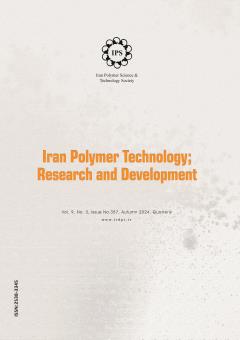مروری بر روش اختلاط فیزیکی برای جلوگیری از رسوب در غشاهای پلیمری
الموضوعات :
1 - دانشگاه صنعتی سهند- دانشکده پلیمر
2 - دانشگاه صنعتی سهند تبریز
الکلمات المفتاحية: جدایش فازی, رسوب, مواد ضدرسوب, اختلاط فیزیکی,
ملخص المقالة :
فناوری غشاء یک ابزار ضروری برای تصفیه و جداسازی محلول های مایع، جامد و گاز می باشد که در حوزه وسیعی از کاربردهای صنعتی و پزشکی استفاده می شود. با وجود استفاده گسترده در این زمینه ها، غشاهای مبتنی بر پلیمر همچنان با چالشهای متعددی از جمله ناپایداری، مقاومت مکانیکی پایین و تمایل به رسوب مواجه هستند. نکته اخیر توجه گروه های تحقیقاتی متعددی را در سراسر جهان به خود جلب کرده است. یک روش مناسب برای تهیه غشاهای ضد رسوب از طریق اختلاط فیزیکی است، که یک روش یک مرحلهای است که شامل مخلوط کردن پلیمر زمینه اصلی و مواد ضد رسوب قبل از ریختهگری و تشکیل فیلم توسط فرآیند جدایش فازی است. این بررسی بر توسعه اخیر غشاهای ضد رسوب از طریق این روش متمرکز است و در ابتدا به فرآیندهای جدایش فازی مختلف از جمله جدایش فازی ناشی از غیرحلال، جدایش فازی ناشی از بخار، جدایش فازی ناشی از حرارت و جدایش فازی ناشی از تبخیر میپردازد. در این مطالعه، کاربرد مواد ضد رسوب پلیمری مانند نانوسلولز، پلیمرهای آبدوست، پلیمرهای سولفون دار، پلیمرهای بلوکی دومحیط دوست و غیره برای دستیابی به خواص ضد رسوب و بهبود عملکرد غشاهای حاصل از منظر شار آب خالص، درصد رد و نرخ بازیابی شار بررسی میشود. نتایج این مطالعه نشان میدهد که اختلاط فیزیکی با مواد ضد رسوب مناسب روشی موثر برای کاهش میزان رسوب و بهبود عملکرد غشاها میباشد.
1. Baker, R. Membrane Technology and Applications, 2nd ed.; John Wiley & Sons, Ltd.: Hoboken, NJ, USA, 2004.
2. Ezugbe, E.O.; Rathilal, S. Membrane Technologies in Wastewater Treatment: A Review. Membranes, 10, 89,2020.
3. Zhang, R.; Liu, Y.; He, M.; Su, Y.; Zhao, X.; limelech, M.; Jiang, Z. Antifouling membranes for sustainable water purification: Strategies and mechanisms. Chem. Soc. Rev., 45, 5888–5924,2016.
4. Li, Chengcai, et al. "Graphene oxide incorporated thin film nanocomposite nanofiltration membrane to enhance permeation and antifouling properties." Desalination and Water Treatment 317، 2024.
5. Desiriani, Ria, et al. "Preparation of polyethersulfone ultrafiltration membrane coated natural additives toward antifouling and antimicrobial agents for surface water filtration." Journal of Environmental Chemical Engineering, 12, 111797, 2024.
6. Yuan, X.S.; Liu, W.; Zhu, W.Y.; Zhu, X.X. Enhancement in Flux and Antifouling Properties of Polyvinylidene Fluoride/Polycarbonate Blend Membranes for Water Environmental Improvement. ACS Omega, 5, 30201–30209,2020.
7. Mu, Y.; Feng, H.; Wang, S.; Zhang, S.; Luan, J.; Zhang, M.; Yu, Z.; Wang, G. Combined strategy of blending and surface modification as an effective route to prepare antifouling ultrafiltration membranes.J. Colloid Interface Sci., 589, 1–12, 2021.
8. Li, X.; Cao, Y.; Kang, G.; Yu, H.; Jie, X.; Yuan, Q. Surface modification of polyamide nanofiltration membrane by grafting zwitterionic polymers to improve the antifouling property. J. Appl. Polym. Sci., 131, 1–9, 2014.
9. Danner, Joseph T., et al. "2-Methylpyrazine: A Greener Solvent for Nonsolvent Induced Phase Separation (NIPS) Membrane Fabrication." Industrial & Engineering Chemistry Research (2024).
10. Li K, Krantz W, Greenberg A, Sani R, Membrane formation via thermally induced phase separation (TIPS): model development and validation. J Membr Sci 279:50–60, 2006.
11. GHASEMI, S.M; KHOLGHI, A. Porous films prepared from poly (styrene-co-acrylonitrile)/dichloromethane system via evaporation induced phase separation: Structure-thermodynamic aspects. Progress in Organic Coatings, 168: 106885, 2022.
12. Venault A, Chang Y, Wang D-M, Bouyer D A review on polymeric membranes and hydrogels prepared by vapor induced phase separation process. Polym Rev 53(4):568–626, 2013.
13. Figoli A, Marino T, Galiano F In: Figoli A, Cassano A, Basile A (eds) Membrane technologies for biorefining. Woodhead Publishing, Cambridge, pp 29–59, 2016.
14. Padaki M, Surya Murali R, Abdullah MS, Misdan N, Moslehyani A, Kassim MA, Hilal N, Ismail AF Membrane technology enhancement in oil–water separation. A review. Desalination,357:197–207, 2015.
15. Koros WJ, Ma YH, Shimidzu T Terminology for membranes and membrane processes (IUPAC Recommendations1996). Pure Appl Chem, 1996.
16. Saleh TA, Gupta VK Membrane fouling and strategies for cleaning and fouling control. In: Saleh TA, Gupta VK (eds) Nanomaterial and polymer membranes. Elsevier, Amsterdam, pp 25–53, 2016.
17. Alvarado C, Farris K, Kilduff J Membrane fouling, modelling and recent developments for mitigation. In: Hankins NP, Singh R (eds) Emerging membrane technology for sustainable water treatment. Elsevier, Amsterdam, pp 433–462, 2016.
18. Guo W, Ngo H-H, Li J A mini-review on membrane fouling. Biores Technol 122:27–34, 2012.
19. Iritani E A review on modeling of pore-blocking behaviors of membranes during pressurized membrane filtration, Drying Technol 31(2):146–162, 2013.
20. Castro-Muñoz R, Boczkaj G, Gontarek E, Cassano A, Fíla V Membrane technologies assisting plant-based and agrofood by-products processing: a comprehensive review. Trends Food Sci Technol 95:219–232, 2020.
21. Cassano A, Conidi C, Ruby-Figueroa R, Castro-Muñoz R Nanofiltration and tight ultrafiltration membranes for the recovery of polyphenols from agro-food by-products. Int J Mol Sci, 2018.
22. Pichardo-Romero DG-A, Garcia-Arce ZP, Zavala-Ramírez A, Castro-Muñoz R Current advances in biofouling mitigation in membranes for water treatment: an overview. Processes8:182, 2020.
23. Wu, Zixuan, et al. "Nanocelluloses fine-tuned polyvinylidene fluoride (PVDF) membrane for enhanced separation and antifouling." Carbohydrate Polymers 323, 121383, 2024.
24. Febriasari, A., Huriya, Ananto, A. H., Suhartini, M., & Kartohardjono, S., Polysulfone–polyvinyl pyrrolidone blend polymer composite membranes for batik industrial wastewater treatment. Membranes, 11(1), 66, 2021.
25. Wen, Xin, et al. "Fabrication of an antifouling PES ultrafiltration membrane via blending SPSF." RSC advances 12.3، 1460-1470, 2022.
26. Khan, Raja Muhammad Asif, et al. "Ultrafiltration polyanionic poly (3‐sulfopropyl methacrylate) membranes with enhanced antifouling and water flux." Polymers for Advanced Technologies 35, e6350, 2024.
27. Yong, Ming, et al. "Properties of polyvinyl chloride (PVC) ultrafiltration membrane improved by lignin: Hydrophilicity and antifouling." Journal of membrane science 575،50-59, 2019.
28. Khosroshahi, M. Monsefi, et al. "Novel polyvinyl chloride ultrafiltration membranes blended with amphiphilic polyethylene glycol-block-poly (1, 2-dichloroethylene) copolymer for oily wastewater treatment." Journal of Water Process Engineering 56, 104433, 2023.


